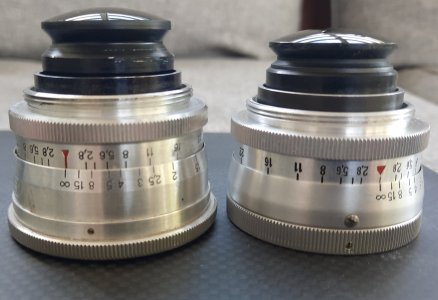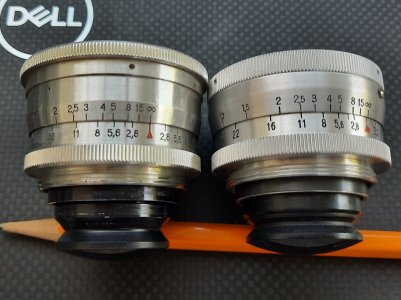Add that to my list of lenses to compare.
You are using an out of date browser. It may not display this or other websites correctly.
You should upgrade or use an alternative browser.
You should upgrade or use an alternative browser.
Early Russian Lenses, What Features to look for.
- Thread starter Sonnar Brian
- Start date
- Latest activity Latest activity:
- Replies 237
- Views 18K
dexdog
Veteran
I have been tempted to try a comparison of 8.5cm/2 Sonnars and J-9s. I have an uncoated CZJ from 1933, a partially coated one from 1937, a couple coated CZJ 285 series in LTM and 1951 and 1952 J-9s in LTM. Lastly, there are the Zeiss-Opton, Carl Zeiss and post-WW2 CZJ versions. Too many to do at one swell foop of course, but will ponder how to set it up. Suggestions welcome!
I have a similar array of Biogons and J-12s
I have a similar array of Biogons and J-12s
This is why I like shooting at the Marine Museum- constant lighting on some life-like figures. I'll do fence slats when re-assembling lenses, especially after swapping elements- but not for comparisons.I have been tempted to try a comparison of 8.5cm/2 Sonnars and J-9s. I have an uncoated CZJ from 1933, a partially coated one from 1937, a couple coated CZJ 285 series in LTM and 1951 and 1952 J-9s in LTM. Lastly, there are the Zeiss-Opton, Carl Zeiss and post-WW2 CZJ versions. Too many to do at one swell foop of course, but will ponder how to set it up. Suggestions welcome!
I have a similar array of Biogons and J-12s
deltapuppy
Member
So my CLAd BK has arrived - no serial is visible externally but the rear element is clearly different than the 1963 example on the left. A difference in the width of the focus ring shows up easily in the comparison. I'll shoot and post some pics with each asap. It does seem though that the 1950 example does have the CZJ glass despite no serial.
Attachments
Ko.Fe.
Lenses 35/21 Gears 46/20
Not really if you are using them for real. The difference is next to none, if fact.The early KMZ Jupiters are the best. Sometimes needs adjustment, but always worth it.
My Bessa R came with black Jupiter 8. I took a lot of exposures with it. And later it went to Colton.
I got last year of production J-12 and now I have 300something one from 1950.
The difference is just not worth it and only at 2.8. Latest one was more funky at it and same for the rest. I had many others in-between. No difference in real use.
My experience is opposite of yours. The early KMZ lenses use Schott glass. I have Jupiter-3's made the same year, by KMZ, using each type of glass. The German glass performs better, in terms of flatness of field and being sharp. Both v1 and v2 versions of the KMZ J-3's perform better than the ZOMZ. The Valdai lenses are bad. The Valdai- sloppy machining of the barrel and focus mount, sloppy assembly, and poor optics.Not really if you are using them for real. The difference is next to none, if fact.
My Bessa R came with black Jupiter 8. I took a lot of exposures with it. And later it went to Colton.
I got last year of production J-12 and now I have 300something one from 1950.
The difference is just not worth it and only at 2.8. Latest one was more funky at it and same for the rest. I had many others in-between. No difference in real use.
Some years of the ZOMZ are better than others. On the J-12, the KMZ have been the best.
Last edited:
deltapuppy
Member
I understand. For me just having a war reparations piece is interesting. I use the modern Cosina / Voigtlander 40mm f1.2 on my Bessa T and I didn't 'need' the BK - I suppose to some extent I was motivated by "the thrill of the hunt". I have family in eastern Germany and have visited the recreated CZ workshop/museum in Jena. Having glass that came from there is just cool.Not really if you are using them for real. The difference is next to none, if fact.
My Bessa R came with black Jupiter 8. I took a lot of exposures with it. And later it went to Colton.
I got last year of production J-12 and now I have 300something one from 1950.
The difference is just not worth it and only at 2.8. Latest one was more funky at it and same for the rest. I had many others in-between. No difference in real use.
dexdog
Veteran
dexdog
Veteran
Coldkennels
Barnack-toting Brit.
I can take an educated guess based on the English "passport" I've got for a Jupiter 11 lens in Kiev mount:
The top line appears to be the lens name and serial number - I can only assume what appears to be 70-9 is a shorthand for Jupiter 9.
The line where 31 is written is the resolving power in the centre of the lens (the Jupiter 11 sheet gives it as "lines/mm, not less than" - incidentally, it gives the measurement for a J11 as 43)
The next line is the same measurement at the "peripheral" (corners? edge?) - the Jupiter 11 also comes in at 21 lines/mm here.
The final line of these measurements would correspond to "working distance, mm" if it follows the structure of the English document - if so, note that it's slightly different to the "official" LTM standard of 28.8mm!
dexdog
Veteran
Thanks, coldkennels! The last word above the date of sale is probably "Laboratory" as faked by transliteration. Also probably makes sense given that a laboratory would be responsible for working out the resolvoing power of the lens.
Last edited:
Bill Jones
Contax Lens User
Coldkennels,I can take an educated guess based on the English "passport" I've got for a Jupiter 11 lens in Kiev mount:
The top line appears to be the lens name and serial number - I can only assume what appears to be 70-9 is a shorthand for Jupiter 9.
The line where 31 is written is the resolving power in the centre of the lens (the Jupiter 11 sheet gives it as "lines/mm, not less than" - incidentally, it gives the measurement for a J11 as 43)
The next line is the same measurement at the "peripheral" (corners? edge?) - the Jupiter 11 also comes in at 21 lines/mm here.
The final line of these measurements would correspond to "working distance, mm" if it follows the structure of the English document - if so, note that it's slightly different to the "official" LTM standard of 28.8mm!
What you identify as "70" is possibly a script version of the Russian "ю". So it would be a J9.
dexdog
Veteran
So, after consulting a couple of online translators, I think that the last line is more than likely the date that the lens was tested, and not a date of sale. If this is true, why would a lens be tested 6 years after manufacture? Was the Soviet system that slow?
Most of the lenses I've seen with the inspection certificate had dates fairly close to the manufacture of the lens.
4 years is a big gap. 84.2mm is on the low end of the J-9, which I usually see 84.5mm indicated.
Very Interesting.
4 years is a big gap. 84.2mm is on the low end of the J-9, which I usually see 84.5mm indicated.
Very Interesting.
Coldkennels
Barnack-toting Brit.
Looking at the writing, I think I see a 2 under the 8 (notice the tail flicking up to the r on the right looks similar to the second 2 in the 22 on the left). The 8 is obviously added in later (different ink, different handwriting), so the real question is why was the document altered later on? Was the lens re-tested, or was it discovered in a box somewhere after the initial testing and had the documentation altered to make it seem like it had been made and tested more recently?So, after consulting a couple of online translators, I think that the last line is more than likely the date that the lens was tested, and not a date of sale. If this is true, why would a lens be tested 6 years after manufacture? Was the Soviet system that slow?
dexdog
Veteran
Bottom to top, 1950, 1951 and 1953 Jupiter 12s. The first two have alloy optical fixtures, while the 1953 is brass. I have long wondered about the metal collar around the rear elements, some have it, others do not, but I think most that I have seen on eBay do not have the collar. The first two lenses look exactly like a couple of my 284 series CZJ Biogons in LTM. My pair of 271 series CZJ Biogons in LTM have the metal collar.


Last edited:
dexdog
Veteran
You may be correct about the date being altered. I have looked that the passport with a 10x, there might be a "2" under the "8", but even on the original, cannot say for certainLooking at the writing, I think I see a 2 under the 8 (notice the tail flicking up to the r on the right looks similar to the second 2 in the 22 on the left). The 8 is obviously added in later (different ink, different handwriting), so the real question is why was the document altered later on? Was the lens re-tested, or was it discovered in a box somewhere after the initial testing and had the documentation altered to make it seem like it had been made and tested more recently?
deltapuppy
Member
Is there anything approaching a consensus on when Zeiss Sonnar optical blocks used in ZKs ran out? An e-bay seller in Moldova has a 1953 J3 listed (s/n 5300950) with (modified?) text that I believe may have originated on the Sovietcam site stating "It is assumed that all lenses produced before 1954 are equipped with Carl Zeiss glass from reparations to the Soviet Union." I got a refreshingly straightforward reply from a Ukranian seller in Poland re ZKs saying " I’ll tell you more - there’s no point in looking for them for the sake of photographing. There are a lot of fakes, or broken glass in the original ones, or replaced glass.
It makes sense to just buy a Sonnar and be happy, it’s certainly no worse than a clone."

It makes sense to just buy a Sonnar and be happy, it’s certainly no worse than a clone."

Last edited:
dexdog
Veteran
I think that 1954 is the consensus for when the Soviets ran out of glass from Schott that was taken from the Zeiss companies. I Have looked at that eBay listing, it is a good looking lens.
I have a 1956 KMZ Jupiter-3 that is a "v1", uses the German glass. KMZ changed the design of the J-3 rear fixture when moving to the new glass. The rear triplet is not interchangeable between V1 and V2 J-3's, or between V2 and 5cm F1.5 CZJ Sonnars. Production of the V1 and V2 J-3 overlapped for a while, maybe the elements were manufactured and waited to be mounted.
Similar threads
- Replies
- 6
- Views
- 590
- Replies
- 8
- Views
- 730
- Replies
- 3
- Views
- 165
- Replies
- 16
- Views
- 2K





